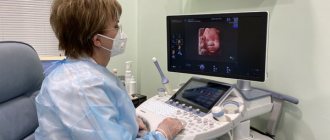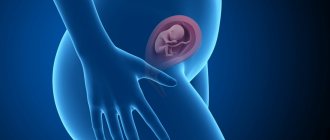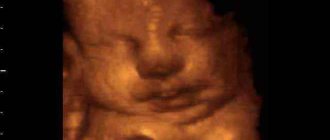Late gestation involves not only the mother's anticipation of meeting her baby soon, but also close monitoring of the child's development in the womb and the state of health of the pregnant woman by specialists. Carrying out medical monitoring is practically impossible without a diagnostic procedure such as ultrasound.
The primary role is played by ultrasound indicators at the 33rd week of pregnancy, when the process of baby formation is at the terminal stage. In order to make the most reliable interpretation of the identified parameters, it is necessary to study in advance their designations, individual characteristics, and possible norms. This article will reveal the essence of the key values in as much detail as possible, answering the most important questions.
What's happening
Although your baby is almost ready to be born, the process of improving the little organism continues. The work of the main systems - the central nervous, immune and endocrine - is established. The pulmonary alveoli have matured, the blood vessels have thickened, and brain development has not stopped.
The appearance of the fetus at the 33rd week of pregnancy is as close as possible to the appearance of a newborn baby. The body became proportional, and the fluff covering it (lanugo) began to disappear. A child's eyes can distinguish between light and darkness and are able to focus in different directions. The ears have not yet fully formed, but the cartilage has become stronger. Your baby not only senses tastes, but also distinguishes smells: for example, he may not like the too strong aroma of perfume, which you will immediately recognize by kicks in the stomach.
At 33 weeks of pregnancy, boys' testicles descend into the scrotum. And at this stage, the layer of vernix lubricant thickens in children, which will protect them from injury during childbirth.
The baby moves quite a lot, but keep in mind that each baby's activity is different. However, there is a generally accepted norm - at least 10 movements in 2 hours. If you count more or significantly less movements, you will need to consult a specialist.
Mom's belly
At week 33, a woman may be bothered by the pronounced rhythmic contractions of the fetus that have become regular, which sometimes last about 20 minutes, or, more simply put... the baby’s hiccups. It’s not surprising that a baby hiccups in its mother’s belly. This is another unconditioned reflex that is formed during the prenatal development of the baby. Most likely, hiccups are due to the fact that the fetus swallows amniotic fluid. Sometimes there is too much liquid, sometimes the child does not do it very carefully... Be that as it may, frequent hiccups in a baby can cause discomfort in a woman. There's nothing you can do about it - you'll have to endure it. If bouts of hiccups recur too often, be sure to tell your doctor.
How you feel
At 32–33 weeks of pregnancy, you occasionally feel Braxton Hicks training contractions, which prepare your uterus for labor. There should be no painful sensations, and if they do appear, they usually go away while lying down. At such moments, be attentive to your condition and, if contractions do not stop for a long time, and even become regular, call an ambulance immediately! This may be a sign of premature labor.
At 33 weeks of pregnancy, the urge to urinate becomes more frequent, and you have to constantly go to the toilet day and night. Try not to drink a lot of fluids before bed.
Half of expectant mothers develop a runny nose. Women with allergies are most at risk of developing rhinitis. You can combat this problem by rinsing your nose with saline, using special drops (be sure to consult your doctor before using them) and humidifying the premises during the heating season.
Also, at 33 weeks of pregnancy, many women are concerned about inflammation and bleeding of the gums. Gingivitis can be a consequence of both hormonal changes in the body and insufficient oral hygiene. Brush your teeth with toothpaste at least twice a day and simply brush after every meal. Don't ignore dental floss, and the best way to relieve inflammation is to rinse with a saline solution.
At 32–33 weeks of pregnancy, you continue to suffer from pain in the back, sacrum and lower back. Try to maintain correct posture, regularly unload your spine by taking a lying or semi-lying position, wear a bandage (only with the approval of a doctor), and for a comfortable sleep, use an orthopedic pillow and mattress.
A lot of stress is now placed on my legs. Massages and cool foot baths will help reduce pain. And to prevent the occurrence of cramps, you need to introduce foods containing calcium into your diet, and from time to time raise your legs to an elevated position from a lying position.
In addition to the legs, at 33 weeks of pregnancy, the arms, namely the wrists, often suffer. Expectant mothers, especially those whose work involves a computer, may experience carpal tunnel syndrome. Its symptoms are numbness in the fingers, tingling sensation and pain in the hand. Massage and special hand exercises help to cope with the problem.
Necessary studies and analyzes
The 33rd obstetric week of pregnancy is the period at which both the doctor and the expectant mother herself have a detailed understanding of how the fetus develops. Monitoring of his condition begins from the moment the mother registers with the antenatal clinic. The doctor calculates the obstetric period, which is determined not from the moment of conception (release of an egg as a result of ovulation, fusion with sperm and formation of an embryo-blastocyst), but from the first day of the last menstruation.
After this, the gynecologist prescribes regular tests, the most important of which is a triple test for genetic abnormalities in the embryo. Studies on the level of hCG hormone and free estriol, AFP protein are carried out at 11-13 weeks. If the test does not reveal any abnormalities, then by week 33 the expectant mother should visit the doctor twice a week. At her appointment she will undergo the following procedures:
- interpretation of urine and blood tests;
- taking a smear if there are complaints;
- measuring blood pressure, body weight, abdominal volume and uterine size;
- monitoring the fetal heartbeat using a stethoscope.
If pregnancy occurs with complications, the doctor will prescribe additional studies and tests, and the frequency of appointments may increase. If there is a threat to the life and health of the child, the expectant mother may be sent to the hospital.
Risk factors
At the 33rd week of pregnancy, there is a high risk of placental abruption. Normally, this should occur at the end of labor, but in some cases this process begins much earlier. The placenta may detach partially or completely. In this case, severe abdominal pain occurs and bloody discharge from the vagina appears. This condition is dangerous due to large blood loss for the mother and suffocation for the baby, since without the placenta, oxygen ceases to flow to the fetus.
Another problem of 33 weeks of pregnancy is late toxicosis, which also causes oxygen starvation of the child. To avoid such problems, monitor your health and be sure to inform your doctor about any changes.
How to deal with leg swelling at 33 weeks
Swelling during pregnancy at this stage is a widespread phenomenon. Expectant mothers complain of swelling of the legs (especially in the ankles), which worsens after physical activity or a walk. Swelling of the legs in pregnant women is associated with a violation of the speed of blood flow: after all, the growing uterus puts pressure not only on the internal organs, but also on the blood vessels. And the blood, being under pressure, retains water in the legs.
To prevent edema during rest, it is necessary to place your feet above your head, for example, on a pillow or a rolled-up blanket, wear comfortable shoes for pregnant women and perform special exercises. It is not recommended for a pregnant woman to stand, sit, or stay in stuffy rooms for a long time. A pregnant woman's diet should be balanced and healthy. To prevent swelling, it is necessary to limit or completely eliminate the consumption of salt, salty foods and spicy foods. Salt tends to retain fluid in the body, and generously spiced dishes can cause not only an attack of heartburn, but also severe thirst.
Weight gain at 33 weeks of pregnancy ranges from 6.8 kg (with a BMI of more than 26) to 11.9 kg (with a BMI of less than 19.8). To calculate your individual weight gain at 33 weeks, use the pregnancy weight gain calculator.
Medical observation
If you haven't had your third routine ultrasound yet, do it now. During the examination, the doctor will evaluate the development and position of the fetus, the condition of the placenta and umbilical cord. To make sure that the pregnancy proceeds without complications, the specialist will measure your blood pressure and weight, examine your arms and legs for swelling and varicose veins, listen to the fetal heartbeat, and take a smear for analysis. As always, you will need to donate blood (at this stage it is especially important to monitor sugar levels) and urine (one of the key indicators is protein content).
Ultrasound examination in the third trimester is routinely performed at 32 weeks of pregnancy. However, the procedure is indicated several weeks earlier if the attending physician considers it necessary.
The third mandatory ultrasound is necessary in order to assess the growth and development of the child, its position in the ovum, and readiness for delivery.
Ultrasound at 30 weeks: what can be revealed
Starting from 30 weeks, the following deviations can be identified:
- urinary tract obstruction
- heart defects
- Heart rate outside the normal range – increased or decreased
It is recommended to supplement the study with Dopplerometry to establish the full clinical picture of the condition of the embryo, placenta and amniotic fluid. You can conduct research at the Marta Center by making a preliminary appointment.
31 weeks of pregnancy: what is visible on ultrasound diagnostics
Normally, the weight of the fetus is now 1550-1690 g, height up to 42 cm. The formation of the liver occurs, and neural connections are improved. The pancreas enlarges at the cellular level, but it does not yet produce enzymes. The layer of subcutaneous fat becomes larger, causing the skin to become more rounded.
On an ultrasound, in the absence of pathologies, the specialist records the following parameters:
- lungs: maturity 1st degree
- shin 51-59 mm
- forearm 44-52 mm
- shoulder 54 mm (medium)
- hip 60 mm (medium)
- BPD 73-87 mm
- LZR 93-109 mm
Ultrasound 33-34 weeks: why the examination is necessary
Now it is necessary to analyze the condition of the expectant mother and child for readiness for childbirth. At 33 weeks, you can predict the exact date of birth. Natural childbirth and possible complications are assessed. The condition of the placenta and the location of the fetus inside the ovum are determined. At 34 weeks, pathologies can be identified that require changes in delivery tactics. Such disorders include hydronephrosis. A caesarean section is indicated when the specialist records the following data:
- low placenta
- umbilical cord entanglement
- the patient's gestosis and, as a consequence, fetal hypoxia
Ultrasound 35-36 weeks: diagnosis before birth
An unscheduled study can be performed at 35 weeks of gestation. The doctor may prescribe the procedure even later in order to get the maximum clinical picture of fetal development. In this case, diagnosis is carried out at 36 weeks. Now it is important to assess the condition of the amniotic fluid and its quantity. It is also necessary to analyze the placenta for aging. In some cases, excellent quality of the placenta is noted at such a late stage. If the baby is entwined with the umbilical cord, a caesarean section is recommended.
The Martha Center offers you diagnostics both in the early stages of pregnancy and in the later stages. Pricing policy varies in the average range. Sign up for the procedure by calling the numbers provided.
- 8 (horizontal)
- 8 (Velcom)
- 8 (MTS)
or come to Alibegova, 12.
How to prevent stretch marks from appearing
It is difficult to predict their appearance: neither heredity nor the absence of stretch marks in previous pregnancies guarantees that this time too you will manage without them. It is extremely difficult to get rid of stretch marks that have already appeared. Therefore, the best option is prevention. It includes:
- daily systematic body skin care using moisturizers or special creams against stretch marks;
- proper nutrition high in vitamins and minerals, polyunsaturated acids, fiber;
- weight control - do not allow sudden gain;
- wearing a bandage and support underwear;
- light massage of problem areas.
A contrast shower promotes blood circulation and makes tissue more elastic. Exercising during pregnancy will not only help keep your body in good shape, but will also improve the condition of your skin.
Why sing lullabies to your baby in your belly?
What other actions of mom and dad help communicate with the Baby and have an unconditional developmental effect?
Lullabies. There are two well-known and beloved ones - “Sleep, my joy, go to sleep” and “Tired toys are sleeping.” These melodic, drawn-out songs have a good calming and relaxing effect. Warm, kind, sweet words of lullabies familiar to us from childhood, performed by mom or dad, are filled with tenderness, love and care. And this strong connection - pleasant emotions and daily lullabies - will lead to the fact that the Baby will begin to recognize songs even before birth.
Let us remind you that the presence of hearing (or lack thereof in you or your husband) does not play a role: there are cases when two-year-old children asked their mothers with perfect pitch not to sing, because “you don’t know how.” Of course, the point here is not in performing skills, but in the feeling and attitude with which the songs are sung towards the Kid.
There is another version of lullabies, which is often liked by dads, since it does not require memorizing words. Mothers resort to it after the birth of the Baby, when the above-mentioned lullabies “with words” have already been sung, and the child does not want to calm down. These are lullabies with the beginning “Bay-bye, bye-bye, my son/my daughter go to sleep.” Apart from the line about a top that will bite the side, few people remember anything from this lullaby. But you can insert any words into it according to the principle “what I see is what I sing about.” It was this method that Shurik used when rocking Helen in the famous “Operation Y”. The song turns out to be almost endless, does not require intellectual effort - only calmness and love for the Baby.
Singing any other (non-lullaby) songs to suit your mood, especially when accompanied by any musical instrument: guitar, piano, harmonica, accordion, etc. By singing your favorite songs from the heart, you instill in your child a special relationship with them. And most likely, these songs will eventually end up in the repertoire of your son or daughter.
Reading children's books out loud - in any volume, that is, as far as the parent's passion is enough. Unlike developmental activities, such a pastime can be unsystematic, that is, depending on the mood, and is aimed at dialogue with the Baby, the desire to be together, on the same emotional wavelength.
A visit to the zoo and circus - traditional places that children like so much. Different sounds and voices combined with the emotions of mom and dad and their comments “for the Baby” are a great way to spend time together.
Good to know
What to do for hemorrhoids in a pregnant woman?
Pregnancy and edema: causes and treatment. What and how much to drink?
How the baby develops inside the belly by week of pregnancy
Pregnancy, swollen legs: what to do? Outdated recommendations and a modern view
Third trimester of pregnancy: how to relieve swelling and prepare for childbirth
Diuretics during pregnancy
All texts for pages about mother and baby were kindly provided by RAMA Publishing - these are chapters from the book by Svetlana Klaas “Your Favorite Little Man from Conception to Birth”, reviewer Irina Nikolaevna Kononova, Candidate of Medical Sciences, Associate Professor of the Department of Obstetrics and Gynecology of the Ural State Medical Academy (Ekaterinburg).








